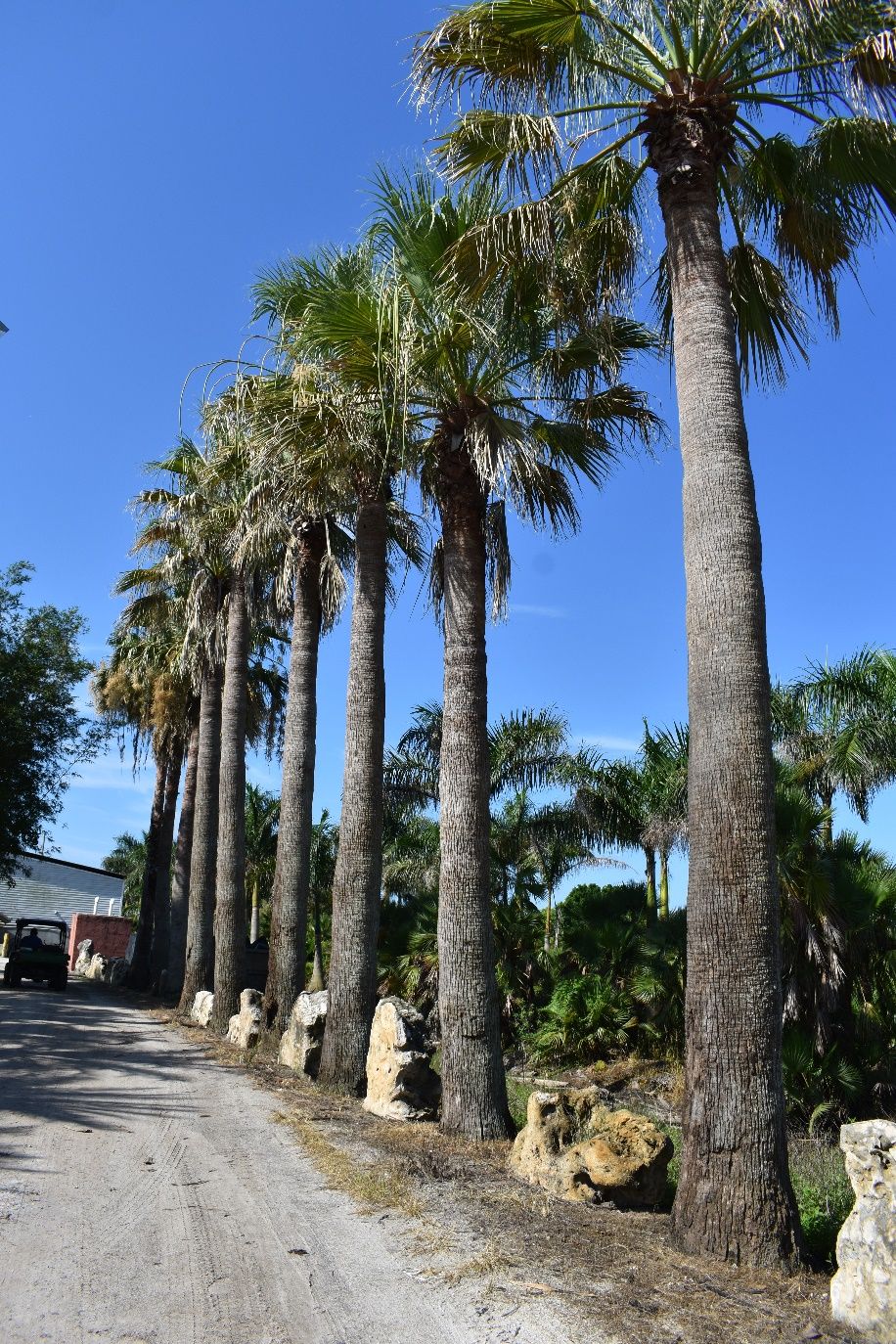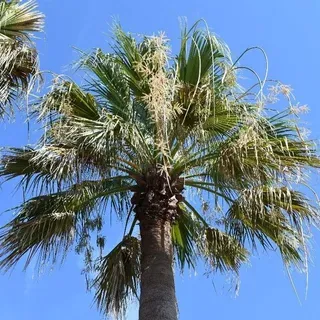Washingtonia filifera: Desert Palm
Introduction
Commonly seen at 40 to 50 feet but capable of soaring to 80 feet in height, desert fan palm is quickly recognized as related to the much-overused, straight, single-trunked street palm of years past, Washingtonia robusta. However, desert fan palm is better suited to the home landscape since it grows more slowly and is shorter. This also allows it to be used in more garden applications, such as containers or grouped together as a mass planting. It does not grow well when it is over-irrigated in Florida because it frequently develops trunk or root rot.

Credit: Stephen Brown, UF/IFAS
General Information
Scientific name: Washingtonia filifera
Pronunciation: wosh-ing-TOE-nee-uh fill-LIFF-er-uh
Common name(s): Desert palm, California washingtonia palm
Family: Arecaceae
USDA hardiness zones: 9A through 11 (Figure 2)
Origin: not native to North America
Invasive potential: not assessed/incomplete assessment
Uses: street without sidewalk; tree lawn 3-4 feet wide; tree lawn 4-6 feet wide; tree lawn > 6 ft wide

Credit: UF/IFAS
Description
Height: 40 to 60 feet
Spread: 10 to 15 feet
Crown uniformity: symmetrical
Crown shape: palm, upright/erect
Crown density: open
Growth rate: moderate
Texture: coarse
Foliage
Leaf arrangement: alternate (Figure 3)

Credit: Stephen Brown, UF/IFAS
Leaf type: costapalmate
Leaf margin: entire
Leaf shape: star-shaped
Leaf venation: palmate
Leaf type and persistence: evergreen, broadleaf evergreen
Leaf blade length: more than 36 inches
Leaf color: green
Fall color: no color change
Fall characteristic: not showy
Flower
Flower color: yellow, white/cream/gray (Figure 3)
Flower characteristics: not showy
Fruit
Fruit shape: oval, round
Fruit length: less than 0.5 inch
Fruit covering: fleshy
Fruit color: black
Fruit characteristics: does not attract wildlife; not showy; fruit/leaves not a litter problem
Trunk and Branches
Trunk/bark/branches: branches don't droop; not showy; typically one trunk; thorns
Pruning requirement: needed for strong structure
Breakage: resistant
Current year twig color: not applicable
Current year twig thickness:
Wood specific gravity: unknown
Culture
Light requirement: full sun
Soil tolerances: clay; sand; loam; acidic; alkaline; well-drained
Drought tolerance: high
Aerosol salt tolerance: moderate
Other
Roots: not a problem
Winter interest: no
Outstanding tree: no
Ozone sensitivity: unknown
Verticillium wilt susceptibility: resistant
Pest resistance: resistant to pests/diseases
Use and Management
The lower leaves persist on the tree after they die, forming a dense, brown, shaggy covering below the living, grey/green, broad, fan-shaped leaves, giving it the common name of petticoat palm. These dead fronds are known to be a fire hazard and a popular bedding roost for rodents and, because of this, must be removed by law in some areas.
Plant this palm only on soil which is extremely well-drained to prevent trunk or root rot. Moderate salt tolerance allows it to be used close to the coast in several of the southern states. This palm could be tried more in well-drained sites as a replacement for Washingtonia robusta which grows very tall with a skinny trunk. But over-irrigation and rainy weather could initiate root rot. Washingtonia filifera is shorter, has a thicker trunk, and is better suited for planting in dry urban landscapes, such as in Texas, Arizona, and California. They reportedly suffer and often die from root rot when irrigated. Select Washingtonia robusta in an irrigated landscape and for the eastern US.
Propagation is by seed.
Pests
Scales while young, palm weevil in old age, palm leaf skeletonizer and a variety of scales at any time can infest this palm.
Diseases
Trunk or root rot in wet soils may infect this tree.



